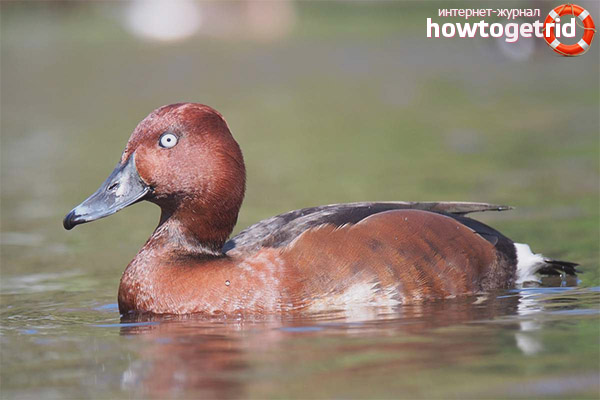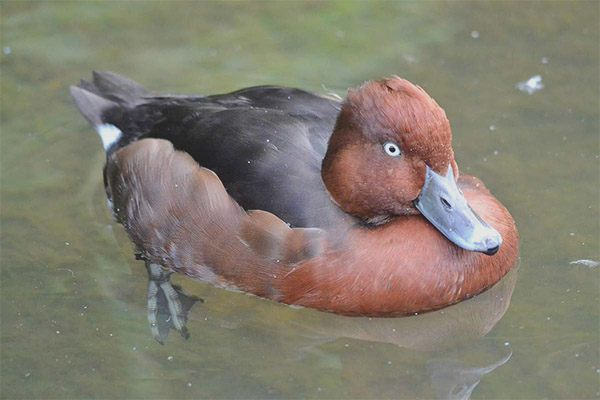The content of the article
The white-eyed dive is a family of diving ducks; they are of medium size and have a dark brown or red head.
What are the outward signs of a white-eyed dive?
Weight can be from 400 to 800 grams. The body is 42 cm in size, with wings ranging from 63 to 67 cm. The female differs from the male in the color of its plumage. Their neck and chest have a purple tide more and there is a black ring around their neck. The neck is at the back and the upper tail is black-brown. The belly is practically all white, the chest is dark.
The undertail of the white-eyed dive is white, it is very clearly visible when the bird is in flight. There are stripes on the wings, they are also white in color, but for them to become noticeable, the duck must take off, in a sitting position you cannot distinguish them. A distinctive feature of this type are white eyes. The color of the female and male is quite similar to each other, but in females it is not so bright and contrasting.There is no metallic luster in a brown-red color. Above the body is brown. The belly begins in a dark color, and smoothly turns into light shades on the chest.
Females of this species and young ducklings possess an iris of red and brown color. On the wings there is a white color. The tail of the females is also white. In ducks, limbs have a rich dark gray color. Males have white eyes, and externally the color of the plumage is the same with the female. It is possible to distinguish a young bird from an adult duck by undertail, for young ducks it does not have a pure white color, it is supplemented with a slightly variegated spots and a dirty tinge. The difference between the white-eyed dive and other ducks is that it does not sit too deep on the water, its tail is raised high. Flies up easily, without complications.
Where dwells?
You can meet the white-eyed dive not only in the reservoir, but also in semi-desert terrain or steppe. Of course, most often a duck can be found in a flat reservoir, but forest-steppe is not an exception. They settle on salt and fresh lakes, build their nests in the river deltas. They choose places where there is reed, rod and reed, all this is best suited for them. This location attracts ducks for its secrecy and secret lifestyle.In the cold season, with the arrival of winter, the birds move to the sea coasts or remain on a large pond in which there is a lot of floating vegetation.
Breeding and nesting process
They can equip their nest on the shore of a reservoir, but this rarely happens. Most often this occurs in an abandoned tree or a muskrat hole. It can be seen that the duck does not nest alone, but with its feathered relatives. Their nests are located at a short distance from each other. As the main building material they choose plant garbage and fluff.
The eggs laid by the female can be red-cream or creamy white. The quantity is different - from 6 to 15 pieces.Only the female hatches the eggs, this process takes 24 -28 days. While the duck is hatching eggs, the male rests in the vegetation not far from the nest itself, but as soon as the chicks appear, he helps to drive them. Males molt during broods, too. During the season, ducks of this type produce one brood. Independent flights of ducklings begin in 55 days. A year later, they already lead offspring. In the last summer month, ducks prepare to fly, fly away to winter to the coast of the Caspian Sea and the Mediterranean, and then their course is directed to south-western Asia.
What eats white-eyed dive?

Such ducks prefer food of plant type. They eat all the plants that are in the water or on its surface, can feed on vegetation that is on the shore near the reservoir. In addition, invertebrates are present in their diets, it may be larvae, insects, mollusks and crustaceans. They catch them right in the pond.
Behavior
The ducks are very active in the morning and evening. During the daytime, they are calm and relax on the water. In general, we can say that the lifestyle of the white-eyed dive is secretive.The birds feed near the reservoir and it is not so easy to notice them, which indicates their caution and forethought.
Spread on the planet
White-eyed dives have become widespread in Kazakhstan, Europe and even Western Asia. Today, this bird is considered rare since it has disappeared from many localities. There is evidence that she flew north to the middle taiga, and nested in the southern taiga.
The extreme border, which is located in the north of Russia, is the area of duck nesting. It is worth saying that over a period of 10 to 15 years, the territory over which this species of bird spread was significantly reduced. Today, the white-eyed dive viet its nests in the territory of the Azov region and the lower Volga region, as well as the duck can be found in southern Siberia and Ciscaucasia.
In Kazakhstan, Central Asia and in the Middle and Near East dive lives. As for the northern boundary of bird nesting, it is not constant, often changing. Wintering ducks occur on the Azov, Black, Caspian and Mediterranean coasts. It happens that they remain in the inland waters of Turkey.During the flight, they may end up on the western side of the Caspian Sea, if the air temperature is not very high, then they remain to winter there.
Possible threat to existence

The most terrible threat to the white-eyed dive habitat is the disappearance of swamps. Such a duck species in some places reduced its distribution. Land reclamation strongly influenced the reduction of natural bird habitats. But, no less dangerous is the hunt for ducks - this significantly reduces the number of individuals of this species.
Such a species as a white-eyed dive has long been listed in the Red Book of Russia and is in second place to reduce its numbers and range.
Preservation of a type of a white-eyed dive
The territory of reserves and areas where the white-eyed dive lives is strictly guarded. In order to preserve the rare species of birds for the period of their accumulation during migration and wintering, it is necessary to create conservation areas for them.It is necessary to prohibit the hunting of rare species of diving in the reservoirs and near them, where the birds feed.
Interesting in the life of white-eyed dives is that for the extraction of food on the pond blacks dive right under the water. In this state, they can be up to 20 seconds and descend to a depth of three meters. Most of their lives are in the water, they rarely come ashore. The behavior of dives is interesting and unusual, watching them is not only curious, but also fun.











To send